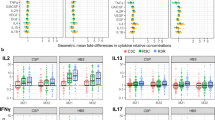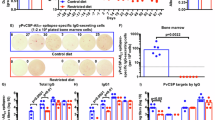Abstract
Objective: To examine the relationship between immunological variables and the different types and severity of malnutrition in Ghanaian children.
Design: Case-control study.
Setting: The study was done at Princess Marie Louise Hospital, Accra, Ghana.
Subjects: One hundred and seventy children, aged 8–36 months, were recruited at the clinical ward and public health service section of the hospital: 61 normal children, 49 moderately malnourished (underweight) children and 60 severely malnourished children (19 kwashiorkor, 30 marasmus, and 11 marasmic kwashiorkor children).
Method: The children underwent clinical observations, anthropometric measurements and blood sampling for biochemical analysis to evaluate their nutritional and immunological status. Serum immunoglobulins (IgA subclasses, IgG subclasses and IgM), complements (C3 and C4) and lymphocyte subpopulations (T cells, B cells, CD4+, CD8+, NK cells and HLADR) were determined for the assessment of humoral and cell-mediated immunity.
Results: Serum levels of IgA1, IgA2 and C4 tended to be higher in severely malnourished children than in normal children, while serum level of C3 and the proportion of B cells were significantly lower in the severely malnourished children than in the normal children (P<0.05). There were no notable differences in most immunological parameters among the three severely malnourished groups. No differences were observed in the immunological parameters except for the proportion of B cells between normal and moderately malnourished children. Factor analysis revealed that C3 levels were positively correlated with a factor which was strongly associated with weight-for-height z-score and biochemical indicators for evaluating protein nutrition. In addition, IgA2, IgG1 and IgM levels were positively correlated with a factor which was associated with C-reactive protein.
Conclusion: Several immunological variables responded positively or negatively with the different levels of severity of malnutrition, but most variables did not on the different types of malnutrition. The changes of C3 level were more associated with the severity of malnutrition.
This is a preview of subscription content, access via your institution
Access options
Subscribe to this journal
Receive 12 print issues and online access
$259.00 per year
only $21.58 per issue
Buy this article
- Purchase on SpringerLink
- Instant access to full article PDF
Prices may be subject to local taxes which are calculated during checkout
Similar content being viewed by others
Author information
Authors and Affiliations
Rights and permissions
About this article
Cite this article
Rikimaru, T., Taniguchi, K., Yartey, J. et al. Humoral and cell-mediated immunity in malnourished children in Ghana. Eur J Clin Nutr 52, 344–350 (1998). https://doi.org/10.1038/sj.ejcn.1600560
Received:
Revised:
Accepted:
Published:
Issue date:
DOI: https://doi.org/10.1038/sj.ejcn.1600560
Keywords
This article is cited by
-
Serum Inflammatory Markers in Children with Severe Acute Malnutrition with Systemic Infections: A Case–Control Study
Indian Journal of Pediatrics (2023)
-
Severe malnutrition with and without HIV-1 infection in hospitalised children in Kampala, Uganda: differences in clinical features, haematological findings and CD4+cell counts
Nutrition Journal (2006)



